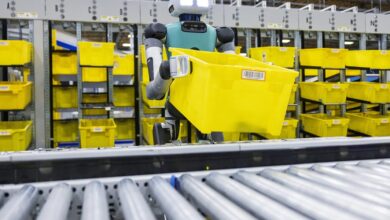Time to get real with robots, stresses National Robotarium CEO

Generative AI may be dominating headlines and boardroom discussions this year, but another sci-fi mainstay is set to become a pressing business concern: robotics.
That’s the message from Stewart Miller, CEO of the UK’s one and only ‘National Robotarium’ – the £22m government-funded Edinburgh research centre, opened in 2022, that hosts startups, conducts research projects, and consults with industry on robotics. He is urging organisations to set out their robotics strategies now, or risk being left behind.
“Not enough business decision-makers actually understand what robots could do for their organisation,” Miller says. “Most companies realise they should be in robotics in some fashion, but they don’t understand the subject matter or what they’re getting themselves into.”
Robotics could be worth $283bn globally by 2032. Analysts expect a huge boost in capital investment for robotics and automation over the next five years as leaders turn to ‘robotics-as-a-service’ providers to drive cost savings and plug labour shortages. Industrial robotics are already huge, with current estimates pegging their value at $84.7bn by the end of 2030. But almost anywhere that people work, robots might have a role to play.
Major technology players are accordingly betting big on robotics. Nvidia recently unveiled Project GR00T, a model for AI-enabled learning in humanoid robots. Growing tech powerhouse China plans to manufacture advanced humanoid robots by next year. If generative AI is set to accompany us in our digital lives, we may soon be standing side-by-side with androids in our physical world.
The droid you’re looking for
Robots are not new. Conceptually, automata date back thousands of years: whether the steam-powered mechanical bird created by Archytas of Tarentum in ancient Greece, or the myths of ‘metal people’ that would recite Buddhist scriptures recorded by eminent Chinese monk, Daoxuan, during the time of the Tang Dynasty.
More recently, Czech author Karel Čapek coined the term ‘robot’ in his 1920 play, Rossumovi Univerzální Roboti. A few decades later, American inventor George Devol invented the world’s first industrial robot, Unimate, which joined General Motors’ production line in 1961.
What is new is that complex, competent, even humanoid robotics are becoming feasible – and increasingly affordable.
Nasa is testing its ‘Valkyrie’ robot, designed to clean damaged environments in space. Amazon is trialling Agility Robotics’ bipedal robot ‘Digit’ for logistics. Tesla’s humanoid machine, Optimus Gen 2, was filmed delicately handling eggs using its tactile finger sensors, offering a tantalising vision of slightly creepy robotic kitchen helpers. Boston Dynamics’ uncanny robotic canine, Spot, would make for a lousy pet, but it can impressively traverse difficult terrain and even ‘see’, ‘hear’, and ‘speak’ in a GenAI-powered British accent.
These are just a few of the most cutting-edge examples. Elsewhere, non-humanoid robots are already cutting and picking crops, assembling machines on production lines, and cleaning environmentally hazardous areas, such as sites polluted by nuclear waste.
But, says Miller, as labour shortages affect industries, from construction and manufacturing to hospitals and hospitality, the economic drivers for robotics adoption will broaden.
Britain, for instance, has a shortfall of tens of thousands of skilled welders for offshore wind turbines. “Anyone in that industry is thinking: how do I construct 10 new wind turbines every week? You’re not going to do that with loads of guys with face masks on and welding torches,” he says. “We’re going to have to use robots to do a big chunk of that.”
Return on investment
Like the oft-repeated message that AI should augment and assist humans, the same will be true for robotics, says Miller. He posits that robotics will do the tasks we simply don’t have the people to do. Rather than replacing humans, he suggests robots will provide additional capacity, allowing organisations to enjoy output and productivity they otherwise wouldn’t.
Accordingly, Miller is on a mission to encourage decision-makers to think about their robotics strategies now – starting by addressing common misconceptions around robotics and return on investment.
More often than not, organisations calculate that humans performing a task would invariably be more affordable. If, for instance, employing people to do a job cost £50,000 a year, why would they buy a £200,000 robot with a four-year payback period instead?
This is “way too simplistic,” says Miller. “If you’re using a robot not to replace someone, but to do a job that’s not being done, it’s a completely different equation”.
Miller points to the berry-picking automatons deployed to cover shortages in seasonal farm work across Europe and Britain. “Without the robot, you’re getting no income. With the robot, you’re generating income you didn’t have before.”
That’s the cost calculation. To actually implement and take advantage of robotics, the National Robotarium is creating a capability maturity model so businesses can assess their readiness. This is in development, but will have five levels, ranging from ‘awareness’ to ‘transformation’. Organisations will be able to run the test online or as part of an exploratory workshop with guidance from the National Robotarium.
Robotics with everything
It was the BBC’s long-running Horizon documentary series that first interested a teenage Miller in engineering, with a special called ‘Chips With Everything’. The episode focused on how microprocessors could change the world, and set him on the path for his 40-year career in avionics, innovation, and engineering.
Miller has seemingly tasked himself with building a world of robotics with everything. (In particular, he’s personally interested in how robots could transform a beleaguered health service – and says a National Health Robotarium “seems bleeding obvious”.)
The UK, though, is lagging behind in adoption. In 2022, the number of robotics installations in the European Union grew by 5% compared to the previous year, with Germany leading the way in the region, at 36% of all those in the EU. Italy and France enjoyed 8% and 13% growth respectively, whereas installations in the UK grew by only 3% – not nothing, but not great.
To boost take-up, Miller recently travelled to parliament to suggest the creation of a new national robotics agency. This, the National Robotarium’s accompanying policy document asserts, would “ensure the UK does not miss out on multi-billion-pound economic growth” from the “robotics revolution”. He’s pitching 10 new Robotariums throughout Britain to help incubate young businesses, plus to serve as testing grounds for industries to experiment with robotics.
Industrial clusters could be formed around these new Robotariums, with industry, academia, and government collaborating on regional economic needs where robots could help – in tandem with creating new manufacturing bases and local upskilling programmes around design, servicing, and maintaining robotics.
And are the politicians heeding his calls? “People appreciate that something needs to be done, but they haven’t gotten to the point of figuring out what the action needs to be,” he says.
“We’re trying to lead them by the nose to say: well, the obvious thing to do is to have more Robotariums.”
Robot psychology
Alongside the actual machines, businesses will also have to think about readying their network capabilities for on-site robotics to function properly – for example with the kinds of ultra-low latency and super-fast speeds enabled by closed 5G networks. At the same time, cybersecurity will need to be water-tight, lest machines pose risks to humans traversing the factory floor or the networks that power them.
The emerging field of ‘robot psychology’, meanwhile, must address how people interact with their new mechanical colleagues, carers, or compadres. In health and social care, for example, organisations need to examine how robotics would interact with patients accessibly. Is it a small, human-esque machine, does it look more like a traditional robot, or is it just a square box?
“There are a lot of things to think about when you’re talking about physical machines,” Miller says. “In particular, thinking about that human dimension where robots and humans are standing side-by-side on your production line or working together in your office space.”
But, as far as Miller is concerned, these are considerations for successful robotics rollouts – not barriers to adoption.



